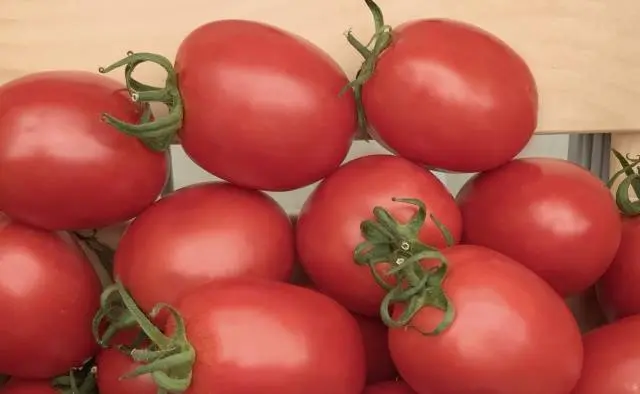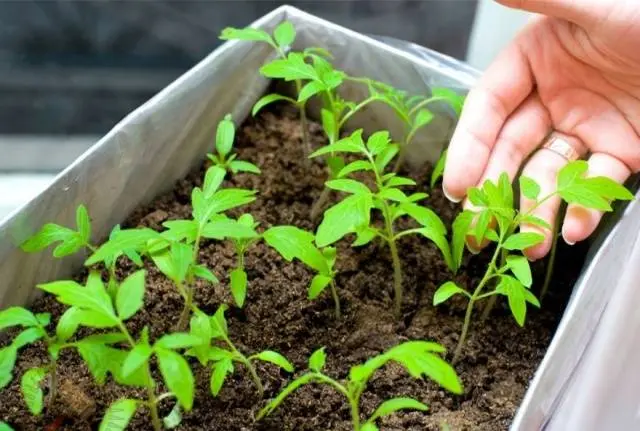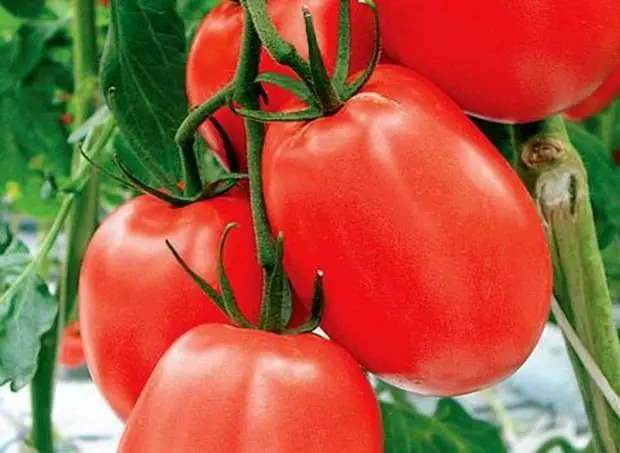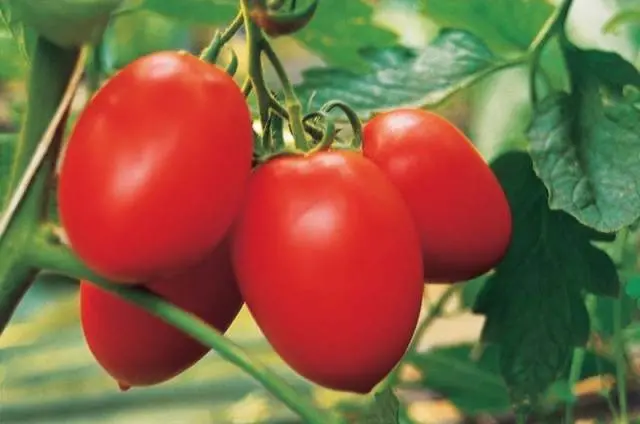Contents
Benito F1 tomatoes are valued for their good taste and early ripening. The fruits have a great taste and universal use. The variety is resistant to diseases and tolerates adverse conditions well. Benito tomatoes are grown in the central zone, in the Urals and in Siberia.
Botanical description
Characteristics and description of the Benito tomato variety:
- medium early maturation;
- from the appearance of sprouts to the harvesting of fruits, it takes from 95 to 113 days;
- height 50-60 cm;
- determinant bush;
- large drooping leaves;
- 7-9 tomatoes ripen on a brush.
Features of the fruits of the Benito variety:
- plum-shaped elongated shape;
- red when ripe;
- average weight 40-70 g, maximum – 100 g;
- pronounced tomato flavor;
- dense pulp with a small amount of seeds;
- thick skin;
- dry matter content – 4,8%, sugars – 2,4%.
The yield of the Benito variety is 25 kg per 1 m2 landings. Fruits are stored for a long time and endure long transportation. They are plucked green at the stage of technical maturity. Tomatoes ripen quickly at room temperature.
Benito tomatoes are used for home canning: pickling, pickling, pickling. During heat treatment, the fruits do not crack, therefore they are suitable for whole-fruit canning.
Getting the seedlings
Benito tomatoes are grown in seedlings. Planting seeds is carried out at home. The resulting seedlings provide temperature and watering. The grown tomatoes are transferred to a permanent place.

Planting seeds
Benito tomatoes are planted in prepared soil. It can be obtained by mixing an equal volume of fertile soil and compost. An alternative option is to purchase peat tablets or ready-made soil mixture.
The soil is treated by heating in an oven or microwave. After 2 weeks, start planting work. Another way to cultivate the soil is to water it with a solution of potassium permanganate.
If the seeds have a colored shell, they do not need additional processing. The manufacturer has covered the planting material with a nutrient mixture from which the plants will receive energy for development.
Containers up to 15 cm high are filled with moistened soil. Benito tomatoes are planted in boxes or separate containers. Seeds are placed with an interval of 2 cm and covered with fertile soil or peat with a layer of 1 cm.
Containers with landings are kept in a dark place. Seed germination is directly affected by room temperature. In warm weather, seedlings will appear a few days earlier.
Care of seedlings
Tomato seedlings Benito F1 provide the necessary conditions:
- Temperature. In the daytime, tomatoes provide a temperature regime in the range from 20 to 25 ° C. At night, the temperature should remain between 15-18°C.
- Watering. Benito tomato seedlings are watered as the soil dries out using a spray bottle. Warm water is sprayed over the soil, preventing it from falling on the stems and leaves of plants.
- Airing. The room with landings is regularly ventilated. However, drafts and exposure to cold air are dangerous for tomatoes.
- Lighting. Benito tomatoes need good lighting for 12 hours. With a short daylight hours, additional lighting is required.
- Top dressing. Seedlings are fed if it has an oppressed appearance. For 1 liter of water, take 2 g of ammonium nitrate, double superphosphate and potassium sulfate.

2 weeks before planting, the tomatoes are hardened in the fresh air. Seedlings are transferred to a balcony or loggia. At first it is kept for 2-3 hours a day. Gradually, this gap is increased so that the plants get used to natural conditions.
Landing in the ground
Benito tomatoes are transferred to a permanent place when the seedlings reach a height of 30 cm. Such seedlings have 6-7 full leaves and a developed root system. Landing is carried out when the air and soil in the beds warm up well.
Soil preparation for tomatoes begins in the fall. The place for planting is chosen taking into account the previous crop. Best of all, tomatoes grow after root crops, green manure, cucumbers, cabbage, pumpkin. After any varieties of tomatoes, peppers, eggplants and potatoes, planting is not performed.
In the spring, deep loosening is performed and holes are prepared for planting. Plants are arranged in increments of 50 cm. In the greenhouse, Benito tomatoes are planted in a checkerboard pattern to simplify care and avoid increased density.
Seedlings are transferred to a new place together with an earthen clod. The soil under the tomatoes is compacted and abundant watering of the plants is carried out. Plants are recommended to be tied to a support at the top.
Care order
Benito tomatoes are cared for by watering, fertilizing, loosening the soil and pinching. According to reviews, Benito F1 tomatoes give a high yield with constant care. The bush is compact, which makes it easy to harvest.

Watering
Tomatoes are watered every week with 3-5 liters of water. The procedure is performed in the morning or evening hours, when there is no direct sunlight.
The intensity of watering depends on the stage of development of tomatoes. The first watering will be required 2-3 weeks after planting. Before the formation of inflorescences, tomatoes are watered weekly with 4 liters of water.
When flowering, Benito tomatoes require more moisture. Therefore, 5 liters of water are added under the bushes every 4 days. When fruiting, excess moisture leads to cracking of the fruit. When the fruits ripen, weekly watering is sufficient.
Moistened soil is carefully loosened so as not to disturb the root system of plants. Loosening improves air exchange in the soil and the absorption of nutrients.
Additional fertilizing
Benito tomatoes need regular feeding. Mineral or organic fertilizers are used as fertilizers. Top dressing is combined with watering plants.
During the season, Benito tomatoes are fed several times. The first top dressing is carried out 10-15 days after planting the tomatoes. An organic fertilizer is prepared for her, consisting of mullein and water in a ratio of 1:10. Tomatoes are watered with a solution under the root.
After 2 weeks, the tomatoes are fed with minerals. For 1 sq. m you need 15 g of superphosphate and potassium salt. Substances are dissolved in water or applied to the soil in a dry form. Similar top dressing is carried out after 2 weeks. It is better to refuse the use of mullein and other nitrogenous fertilizers.
During the flowering period, Benito tomatoes are treated on a leaf with boric acid-based fertilizer. 2 g of the substance is dissolved in 2 liters of water. Spraying helps to increase the number of ovaries.
You can replace minerals with wood ash. It contains calcium, phosphorus, magnesium and other substances necessary for the development of tomatoes. Ash is applied to the soil or insisted for further watering.

Shrub formation
According to its description and characteristics, the Benito tomato variety belongs to determinant varieties. Tomatoes of these varieties are formed into 1 stem. Stepchildren growing from the leaf sinus are cut off by hand.
Pasynkovanie allows you to avoid thickening and get a high yield. The procedure is carried out every week.
Protection against diseases and pests
Variety Benito is resistant to viral mosaic, verticillium and fusarium. To prevent diseases, monitor the level of humidity in the greenhouse and treat the plants with fungicides.
Tomatoes attract aphids, gall midges, mole crickets, whiteflies and other pests. Insecticides help control insects. In order to prevent the spread of pests, plantings are treated with tobacco dust or wood ash.
Reviews of gardeners
Conclusion
Benito tomatoes are suitable for planting under cover or in the open. The variety has a universal application, is unpretentious and gives a high yield with constant care. Tomatoes are watered, fed and stepchildren.









